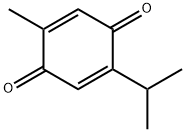|
ChemicalBook Optimization Suppliers |
|
| 化学名: | チモキノン | | 英語化学名: | THYMOQUINONE | | 别名: | 4-dione,2-methyl-5-(1-methylethyl)-5-cyclohexadiene-1;4-dione,5-isopropyl-2-methyl-5-cyclohexadiene-1;5-Isopropyl-2-methyl-p-benzoquinone;p-Cymene-2,5-dione;thymolquinone;P-MENTHA-3,6-DIENE-2,5-DIONE;TIMTEC-BB SBB008296;THYMOQUINONE | | CAS番号: | 490-91-5 | | 分子式: | C10H12O2 | | 分子量: | 164.2 | | EINECS: | 207-721-1 | | カテゴリ情報: | Anthraquinones, Hydroquinones and Quinones;Benzoquinones | | Mol File: | 490-91-5.mol |  |
| | チモキノン Usage And Synthesis |
| 外観 | うすい黄色~褐色粉末~結晶 | | 解説 | 2-isopropyl-5-methyl-1,4-benzoquinone.C10H12O2(164.2). チモキノンは,シソ科,その他の精油に含まれる.黄色の結晶.融点45.5 ℃,沸点232 ℃.冷エタノール,エーテルに易溶,クロロホルム,ベンゼン,ヘキサンに可溶,水に難溶.森北出版「化学辞典(第2版) | | 説明 | Thymoquinone is an allergen In different cedar
species. | | 化学的特性 | orange to brown crystals | | 使用 | Thymoquinone is a phytochemical compound found in the plant Nigella sativa. Thymoquinone has antioxidant effects and has been shown to protect against heart, liver and kidney damage in animal studies, as well as having possible anti-cancer effects. Thymoquinone also has analgesic and anticonvulsant effects in animal models. Thymoquinone is an angiogenesis inhibitor. An IRAK1 inhibitor with in vivo and in vitro anti-inflammatory activities. Dyes and metabolites. | | 使用 | Thymoquinone is a phytochemical compound found in the plant Nigella sativa. Thymoquinone has antioxidant effects and has been shown to protect against heart, liver and kidney damage in animal studies,
as well as having possible anti-cancer effects. Thymoquinone also has analgesic and anticonvulsant effects in animal models. Thymoquinone is an angiogenesis inhibitor. | | 定義 | ChEBI: Thymoquinone is a member of the class of 1,4-benzoquinones that is 1,4-bezoquinone in which the hydrogens at positions 2 and 5 are replaced by methyl and isopropyl groups, respectively. It is a natural compound isolated from Nigella sativa which has demonstrated promising chemotherapeutic activity. It has a role as an anti-inflammatory agent, an antioxidant, an adjuvant, an antineoplastic agent, a cardioprotective agent, an antidepressant and a plant metabolite. | | 接触アレルゲン | Thymoquinone is an allergen in different cedar species,
Cupressaceae family, such as incense cedar (Calocedrus
decurrens Florin) used for pencils, chests or toys, and
western cedar (Thuja plicata Donn.) as used for hard real-
izations such as construction or boats. | | 抗がん研究 | Thymoquinone acts on cell cycleand inhibits progression from G1 toS phase by targeting the cellcycle-related proteins such as cyclinD1, cyclin E and p27.It also exhibits histone deacetylase(HDAC) inhibitory effects andtargets p21 and Maspin.Induces pro-apoptotic gene, Bax,and downregulates anti-apoptoticgene Bcl-2
Barkat et al.(2017) | | 抗がん研究 | The black cumin (Nigella sativa) that has a long history of medicinal use contains aphytochemical called thymoquinone (2-methyl-5-isopropyl-1,4-benzoquinone)(Padhye et al. 2008; Khan et al. 2011). In the regions of Southeastern Asia, Africa,Arab and the Mediterranean, the black cumin seeds have a notable history in traditionalmedicine practices. In ancient Egypt, Greece and Turkey, black cumin seedswere often used to treat many diseases and ailments (Padhye et al. 2008; Salih et al.2009; Khan et al. 2011; Ahmad et al. 2013). The Nigella sativa plant seeds and oilare used for medicinal purposes, and they are known for their hepatoprotective,renal-protective, antimicrobial, antidiabetic, anticancer, antihypertensive, analgesic,anti-inflammatory, immunomodulatory, spasmolytic, gastro-protective, bronchodilativeand antioxidant activities (Salih et al. 2009; Khan et al. 2011; Ahmad et al.2013). Recently, Barkat et al. (2017) reported that administration of thymoquinoneto MDA-MB-231 acts on cell cycle and inhibits progression from G1 to S phase bytargeting the cell cycle-related proteins such as cyclin D1, cyclin E and p27. It alsoexhibits histone deacetylase (HDAC) inhibitory effects, targets p21 and Maspin andinduces pro-apoptotic gene, Bax, and downregulates anti-apoptotic gene Bcl-2(Barkat et al. 2017).
Thymoquinone is the primary bioactive constituent of seed oil of Nigella sativa. It is a chemopreventiveagent and suppresses the proliferation of breast, colorectal, leukemia, osteosarcoma,ovarian, and pancreatic cancer cells. It suppresses TNF-inducedactivationof NF-κB in a time- and dose-dependent manner and the subsequent inhibition ofIκBα kinase activation, IκBα degradation, phosphorylation, p65 nuclear translocation,and phosphorylation. It specifically suppresses the nuclear p65 and recombinantp65 direct binding to DNA. It also downregulates the expression ofNF-κB-regulated antiapoptotic (survivin, IAP1, Bcl-xL, XIAP IAP2, Bcl-2), proliferative(cyclin D1, c-myc, and COX-2), and angiogenic (VEGF and MMP-9) geneproducts. It suppresses the activation of ERK and AKT pathways and blocks in vitroand in vivo angiogenesis (Aggarwal et al. 2008). |
|